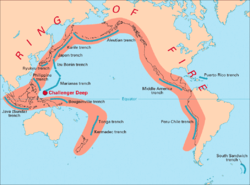
An orogenic belt, orogen, or mobile belt [a] is a zone of Earth's crust affected by orogeny. [2] An orogenic belt develops when a continental plate crumples and is uplifted to form one or more mountain ranges; this involves a series of geological processes collectively called orogenesis. [3] [4]



